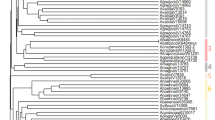Abstract
A collection of vegetatively propagated perennial kales (Brassica oleracea L. var. ramosa DC., 64 accessions in total), predominantly from the Netherlands, was subjected to RAPD analysis in order to confirm or reject the presence of possible duplicates as indicated by isozyme and cytological data, as well as by morphological data described here. By employing 9 decamer primers, seven RAPD patterns could be attributed to almost all of the respective accessions, with up to 22 clones exhibiting identical features for the parameters examined. By these results, a high percentage of duplication is very strongly indicated in the collection, offering possibilities for a reduction in the number of clones to be propagated. The highest level of genetic variation was found in two kales from Portugal, which differed significantly from the other accessions.
Similar content being viewed by others
References
Charters, Y.M., A. Robertson, M.J. Wilkinson & G. Ramsay, 1996. PCR analysis of oilseed rape cultivars ( Brassica napus L. ssp. oleifera) using 50anchored simple sequence repeat (SSR) primers. Theor. Appl. Genet. 92, 442–447.
Demeke, T., R.P. Adams & R. Chibbar, 1992. Potential taxonomic use of random amplified polymorphic DNA(RAPD): a case study in Brassica. Theor. Appl. Genet. 84, 990–994.
Dos Santos, J.B., J. Nienhuis, P. Skroch, J. Tivang & M.K. Slocum, 1994. Comparison of RAPD and RFLP genetic markers in determining genetic similarity among Brassica oleracea L. genotypes. Theor. Appl. Genet. 87: 909–915.
Gladis, T. & K. Hammer, 1990. Die Gaterslebener BrassicaKollektion – eine Einführung. Kulturpflanze 38, 121–156.
Hallden, C., N.O. Nilsson, I.M. Rading & T. Säll, 1994. Evaluation of RFLP and RAPD markers in a comparison of Brassica napus breeding lines. Theor. Appl. Genet. 88: 123–128.
Hanelt, P., 1986. Cruciferae. In: Schultze-Motel, J. (Ed.), Rudolf Mansfelds Verzeichnis landwirtschaftlicher und gärtnerischer Kulturpflanzen (ohne Zierpflanzen), Akademie-Verlag, Berlin. Vol. 1, 272–332.
Hu, J. & C.F. Quiros, 1991. Identification of broccoli and cauliflower cultivars with RAPD markers. Plant Cell Rep. 10: 505–511.
Lux, H. & K. Hammer, 1994. Molecular markers and genetic diversity – some experience from the genebank. In: Balfourier, F. & M.R. Perretant (Eds.), Evaluation and exploitation of genetic resources. Proceedings of the Genetic Resources Section Meeting of Eucarpia, Clermont-Ferrand, 49–54.
Messiaen, C.M., 1992. A note on the transition from seed to vegetative propagation of some European vegetables grown in the Caribbean area. In: Hammer, K., M. Esquivel & H. Knüpffer (Eds.), Origin, evolution and diversity of Cuban genetic resources. Gatersleben, 80–82.
Rogers, S.O. & A.J. Bendich, 1985. Extraction of DNA from milligram amount of fresh, herbarium and mummified plant tissues. Plant Mol. Biol. 5: 68–76.
Thormann, C.E., M.E. Ferreira, L.E.A. Camargo, J.G. Tivang & T.C. Osborne, 1994. Comparison of RFLP and RAPD markers to estimating genetic relationships within and among cruciferous species. Theor. Appl. Genet. 88: 973–980.
Williams, J.G.K., A.R. Kubelik, K.J. Livak, J.A. Rafalski & S.V. Tingey, 1990. DNA polymorphisms amplified by arbitrary primers are useful as genetic markers. Nucleic Acids Res. 18: 6531–6535.
Zeven, A.C., M.S. Ramanna, M. Boeder, Z. Sawor & J. Waninge, 1989. Diploids and natural autotetraploids in the predominantly vegetatively propagated Brassica oleracea L. var. ramosa DC. and their cytology. Euphytica 41: 59–64.
Zeven, A.C., L.C.J.M. Suurs & J. Waninge, 1996. Diversity for enzymes, flowering behaviour and purple plant colour of perennial kale (Brassica oleracea L. var. ramosa DC.) in the Netherlands. In: Dias, J.S., I. Crute & A.A. Monteiro (Eds.), Proc. Intern. Symposium on Brassicas, 61–66.
Author information
Authors and Affiliations
Rights and permissions
About this article
Cite this article
Zeven, A., Dehmer, K., Gladis, T. et al. Are the duplicates of perennial kale (Brassica oleracea L. var. ramosa DC.) true duplicates as determined by RAPD analysis?. Genetic Resources and Crop Evolution 45, 105–111 (1998). https://doi.org/10.1023/A:1008670015789
Issue Date:
DOI: https://doi.org/10.1023/A:1008670015789




